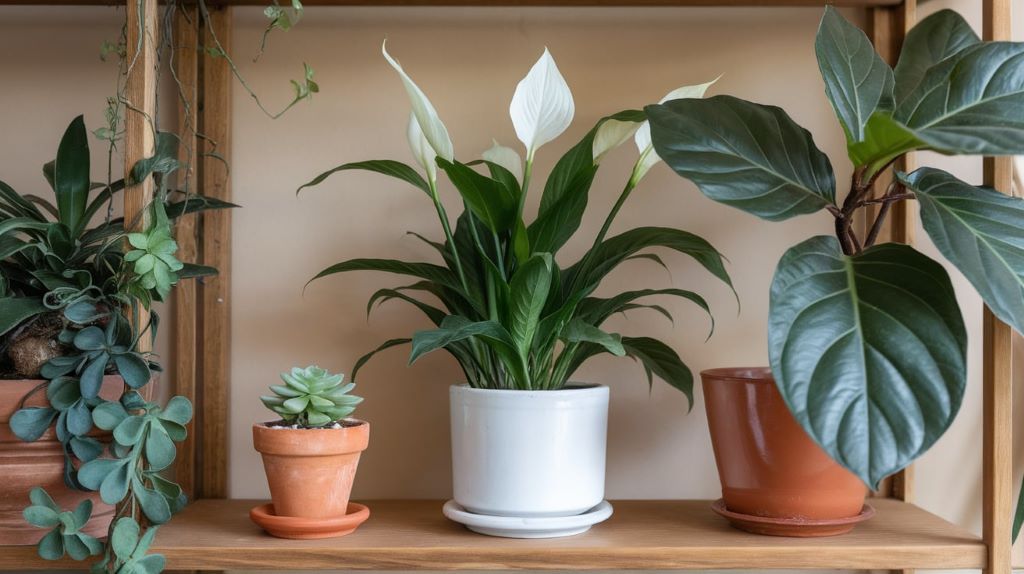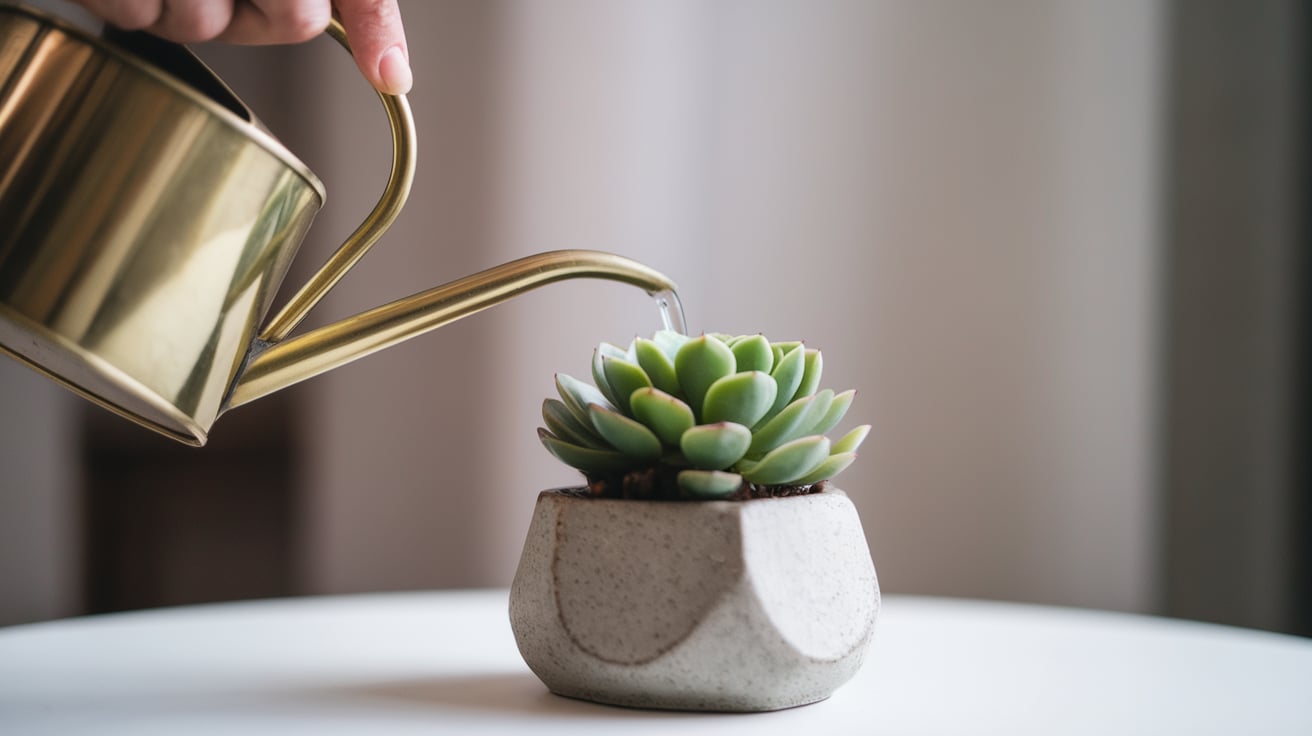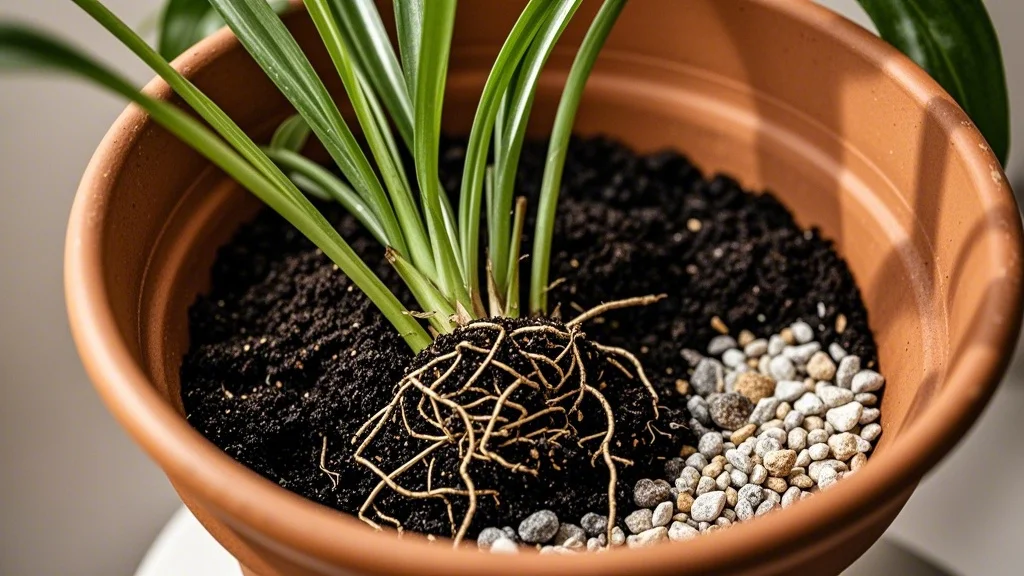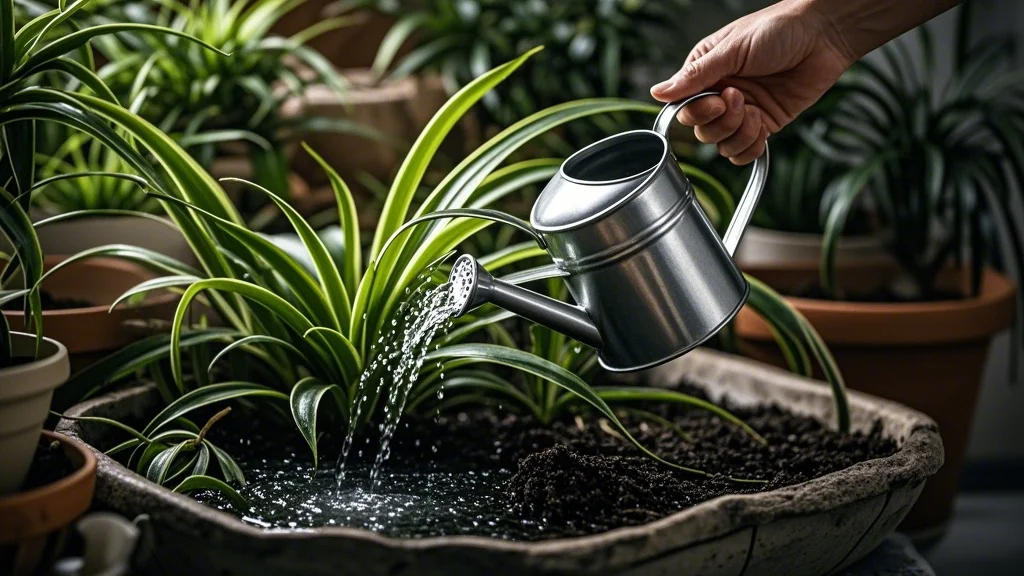Proper watering is crucial for the health and vitality of your indoor plants. With a wide array of watering tools available, finding the right one for your needs can be overwhelming. This comprehensive guide will help you navigate the world of plant hydration systems, from classic watering cans to high-tech moisture meters and automated solutions.
Contents
Traditional Watering Cans
Pros and Cons
Pros:
- Simple and easy to use
- Affordable
- Available in various sizes and designs
- Allows for precise water control
Cons:
- Can be heavy when full
- May require multiple refills for larger plant collections
- Less efficient for hard-to-reach plants
Top Picks
- Haws Indoor Watering Can
- Capacity: 1 liter
- Features: Brass rose for gentle watering, balanced design
- Best for: Small to medium indoor plants
- Bloem Aqua Rite Watering Can
- Capacity: 2.6 liters
- Features: Long spout, ergonomic handle
- Best for: Larger plants or hanging baskets
- OXO Good Grips Indoor Pour & Store Watering Can
- Capacity: 2 liters
- Features: Rotating spout for easy storage, comfortable grip
- Best for: Versatile use in small spaces
Moisture Meters
How They Work
Moisture meters measure the water content in soil, helping you determine when your plants need watering. They typically use electrical conductivity or other sensors to provide accurate readings.
Pros and Cons
Pros:
- Prevents overwatering and underwatering
- Helps you understand your plants’ specific needs
- Can measure other factors like light and pH in some models
Cons:
- Requires regular use for best results
- May need calibration or battery replacement
- Some models can be expensive
Top Picks
- XLUX T10 Soil Moisture Sensor Meter
- Features: No batteries required, simple analog display
- Best for: Beginners and budget-conscious gardeners
- Gouevn Soil Moisture Meter
- Features: 3-in-1 functionality (moisture, light, and pH)
- Best for: Comprehensive plant care
- ECOWITT WH51 Soil Moisture Sensor
- Features: Wireless connectivity, smartphone app integration
- Best for: Tech-savvy gardeners who want remote monitoring
Self-Watering Planters
How They Work
Self-watering planters feature a reservoir that stores water, which is then drawn up into the soil through capillary action or wicking systems.
Pros and Cons
Pros:
- Reduces watering frequency
- Helps maintain consistent soil moisture
- Ideal for vacation periods or busy schedules
Cons:
- Can be more expensive than traditional pots
- May lead to overwatering if not properly managed
- Limited styles and sizes available
Top Picks
- Lechuza Classico Color Self-Watering Planter
- Capacity: 1.6-liter water reservoir
- Features: Water level indicator, removable liner
- Best for: Medium-sized plants with moderate water needs
- Mkono Self Watering Planter
- Capacity: 0.9-liter water reservoir
- Features: Clear water level window, modern design
- Best for: Small to medium plants in contemporary spaces
- Gardenix Decor Self Watering Planter
- Capacity: 3-liter water reservoir
- Features: Large capacity, suitable for outdoor use
- Best for: Larger plants or outdoor container gardens
Watering Globes and Spikes
How They Work
Watering globes and spikes are filled with water and inserted into the soil. They slowly release water as the soil dries out, providing a steady supply of moisture.
Pros and Cons
Pros:
- Low-cost option for automatic watering
- Ideal for short trips or forgetful waterers
- Can be decorative additions to planters
Cons:
- Limited water capacity
- May clog with soil particles
- Can be prone to tipping or breaking
Top Picks
- Blazin’ Bison Watering Globes
- Capacity: 300ml each
- Features: Set of 3, hand-blown glass design
- Best for: Decorative appeal and short-term watering needs
- Blumat Classic Plant Watering Stakes
- Capacity: Varies (works with plastic bottles)
- Features: Adjustable water flow, reusable
- Best for: Customizable watering for various plant sizes
- Aqua Globes AG5240 Watering Bulbs
- Capacity: 200ml each
- Features: Set of 2, sturdy glass construction
- Best for: Small to medium plants with moderate water needs
Automated Watering Systems
How They Work
Automated watering systems use timers, pumps, and sometimes smart technology to deliver water to your plants on a set schedule or based on soil moisture levels.
Pros and Cons
Pros:
- Consistent and precise watering
- Can be controlled remotely via smartphone apps
- Ideal for large plant collections or frequent travelers
Cons:
- Higher initial cost
- May require setup and maintenance
- Potential for system failures or malfunctions
Top Picks
- Gardena Smart Water Control Set
- Features: Smartphone app control, weather-based scheduling
- Best for: Tech-savvy gardeners with outdoor container plants
- Claber Oasis Garden Watering System
- Features: Battery-operated timer, adjustable drippers
- Best for: Indoor plant collections or small greenhouses
- Orbit B-hyve Smart Hose Faucet Timer
- Features: Wi-Fi enabled, weather-based watering
- Best for: Balcony or patio container gardens
Misting Systems
How They Work
Misting systems use fine nozzles to create a light spray of water, ideal for humidity-loving plants or propagation setups.
Pros and Cons
Pros:
- Increases humidity around plants
- Gentle watering for delicate foliage
- Can be automated for consistent misting
Cons:
- May not provide enough water for some plants
- Can lead to fungal issues if overused
- Requires regular cleaning to prevent clogging
Top Picks
- Miracle-Gro Indoor Plant Mister
- Features: Adjustable nozzle, ergonomic design
- Best for: Manual misting of small plant collections
- Reptile Fogger Terrariums Humidifier
- Features: Adjustable mist output, large water tank
- Best for: Creating high-humidity environments for tropical plants
- MistKing Misting System v5.0
- Features: Programmable timer, high-quality misting nozzles
- Best for: Professional-grade misting for large plant collections or greenhouses
Choosing the Right Watering Tool

When selecting a watering tool, consider the following factors:
- Plant Types: Different plants have varying water needs. Succulents may benefit from moisture meters, while tropical plants might thrive with misting systems.
- Collection Size: Larger collections may warrant automated systems, while smaller groups can be managed with traditional watering cans.
- Time and Attention: If you’re often busy or travel frequently, self-watering planters or automated systems might be ideal.
- Budget: Watering tools range from affordable watering cans to more expensive smart systems. Choose one that fits your budget and needs.
- Space: Consider the size of your growing area and choose tools that fit comfortably in your space.
- Tech-Savviness: If you enjoy gadgets, explore smart watering systems. If you prefer simplicity, stick to traditional methods.
Maintenance and Care
To ensure your watering tools function properly:
- Clean and sanitize tools regularly to prevent the spread of plant diseases.
- Check for clogs or blockages in systems with small openings, like misting nozzles or watering globe tips.
- Calibrate moisture meters periodically for accurate readings.
- Inspect automated systems for leaks or malfunctions.
- Replace batteries in electronic devices as needed.
Conclusion

Finding the perfect plant hydration system depends on your specific needs, preferences, and plant collection. Whether you opt for the simplicity of a well-designed watering can or the convenience of a smart watering system, the right tool will help you maintain healthy, thriving plants with ease.
Remember that no tool can replace the care and attention of a dedicated plant owner. Use these tools to supplement your plant care routine, but always stay attuned to your plants’ individual needs. With the right combination of tools and attention, you’ll be well on your way to creating a lush, vibrant indoor garden.








